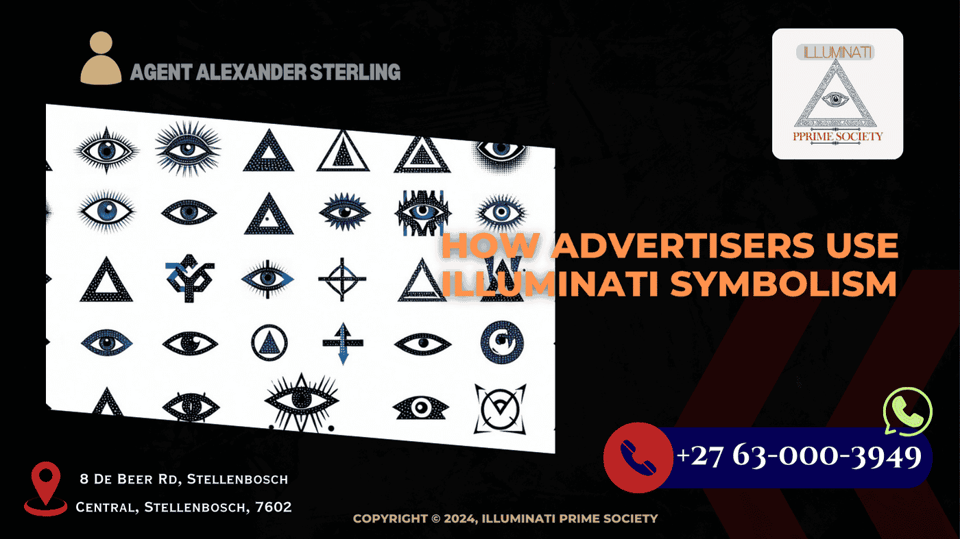Unlock the mysteries behind the secretive hand gestures often attributed to the Illuminati. To...
Unveiling Illuminati Symbolism in Modern Advertising

Unveiling the secret world of marketing: How advertisers subtly incorporate Illuminati symbolism to capture and influence audiences.
To guide you deeper into the Illuminati ecosystem, talk to us:
-
“Ready to share your success story?” → Contact Form
-
“Learn directly from Agent Alexander Sterling” → Agent’s Blog
-
“Speak privately about your path” → Talk to Agent on WhatsApp ✅
- “Explore more member journeys” → /illuminati-member-testimonials
- "Illuminati in Modern Culture" → /illuminati-modern-culture
The Historical Context of Illuminati Symbolism in Popular Culture
Illuminati symbolism has long been a subject of intrigue and speculation. Originating from the Bavarian Illuminati, a secret society founded in 1776, these symbols have permeated popular culture and media. Over the centuries, they have evolved into powerful icons recognized globally.
In the 20th and 21st centuries, these symbols began to appear more frequently in various forms of media, from movies and music videos to fashion and advertising. Their mysterious allure continues to captivate audiences, making them a potent tool for marketers aiming to tap into the subconscious mind of consumers.
Identifying Common Illuminati Symbols in Advertising
Several symbols are commonly associated with the Illuminati and are often used in advertising. The All-Seeing Eye, often depicted within a triangle, is perhaps the most recognizable. This symbol is believed to represent enlightenment and omnipresence, subtly suggesting that the product or brand has an all-encompassing influence.
Another frequent symbol is the pyramid, which can signify power and structure. Advertisers might incorporate these symbols into their logos, product designs, or marketing campaigns to evoke a sense of mystery and authority. Other symbols include the owl (representing wisdom) and the number 666, which, despite its controversial connotations, is sometimes used to provoke curiosity and attention.
Psychological Impact of Symbolism on Consumer Behavior
Symbols have a profound psychological impact on consumer behavior. The use of Illuminati symbolism in advertising taps into the collective unconscious, where these symbols reside as powerful archetypes. This can create a sense of familiarity and intrigue, drawing consumers closer to the brand.
Moreover, the mysterious and often controversial nature of these symbols can generate buzz and discussion around a product, increasing its visibility. This phenomenon is known as the 'curiosity gap,' where consumers are compelled to learn more about the product or brand due to its enigmatic presentation.
Case Studies: Brands Known for Using Illuminati Imagery
Numerous high-profile brands have been noted for their use of Illuminati symbolism. For instance, fashion brands like Versace and Givenchy have incorporated the All-Seeing Eye and pyramid motifs in their designs and advertisements. This not only aligns them with a sense of exclusivity and luxury but also adds a layer of intrigue to their brand identity.
To guide you deeper into the Illuminati ecosystem, talk to us:
-
“Ready to share your success story?” → Contact Form
-
“Learn directly from Agent Alexander Sterling” → Agent’s Blog
-
“Speak privately about your path” → Talk to Agent on WhatsApp ✅
- “Explore more member journeys” → /illuminati-member-testimonials
- "Illuminati in Modern Culture" → /illuminati-modern-culture
In the music industry, artists like Jay-Z and Rihanna have famously used Illuminati imagery in their music videos and stage performances. By doing so, they create a mystique around their persona and brand, encouraging fans to engage more deeply with their content.
Debunking Myths: Are These Symbols Used Intentionally?
There is ongoing debate about whether the use of Illuminati symbols in advertising is intentional or merely coincidental. Some argue that these symbols are deliberately used to manipulate and influence audiences. Advertisers, they claim, are well aware of the psychological impact these symbols can have and use them to their advantage.
Others believe that the prevalence of these symbols is more about their aesthetic appeal and the cultural significance they have amassed over time. Regardless of the intent, their use undeniably adds a layer of complexity and fascination to advertising strategies, making them an effective tool for capturing consumer attention.
.png?width=100&height=100&name=Illuminati%20Prime%20Society%20Logo%20(1).png)

.png?height=200&name=A%20dimly%20lit%20chamber%20featuring%20a%20glowing%20Illuminati%20Vault%20console%20surrounded%20by%20ancient%20manuscripts%20and%20symbols.%20(2).png)
